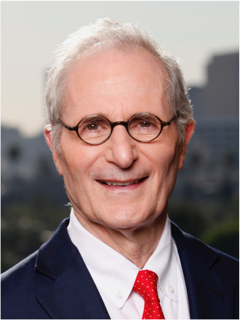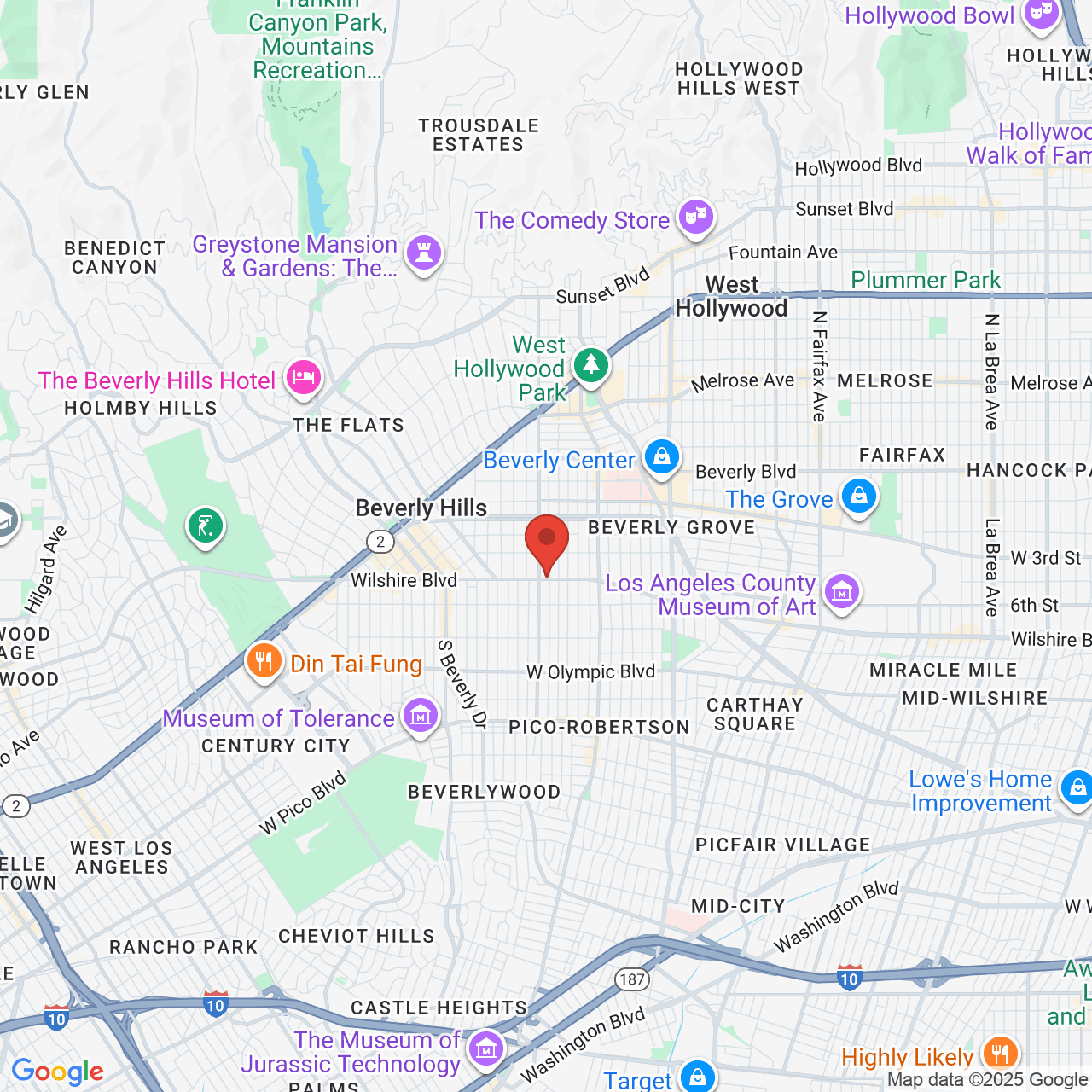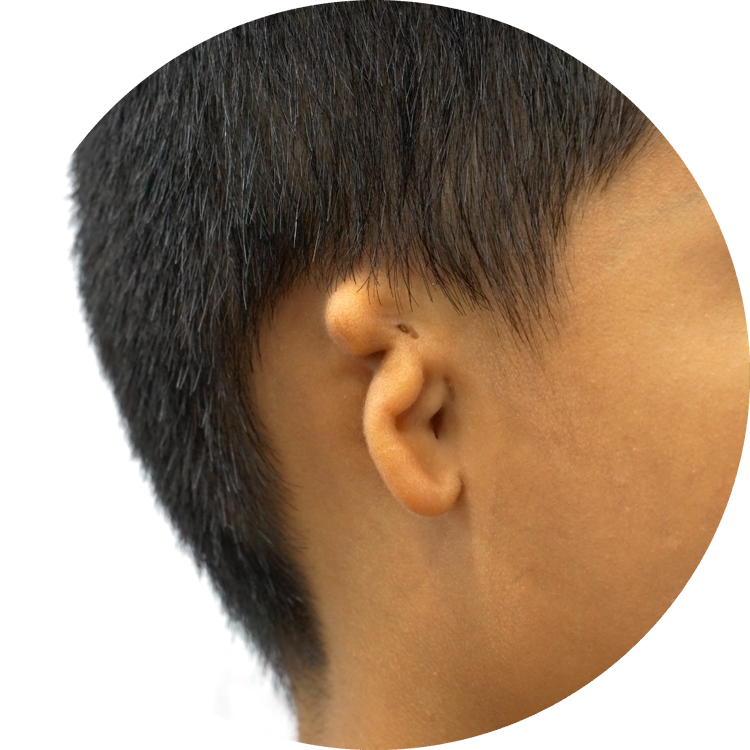
Microtia

Types of Microtia
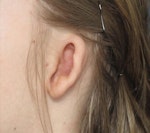
Grade 1
Grade 1 microtia is characterized by an unusually small ear, often with a narrowed or missing ear canal.

Grade 2
Grade 2 microtia is characterized by an abnormally developed outer ear, usually the upper half, often with a narrowed or missing ear canal.

Grade 3
The most common form of the condition is characterized by a small, abnormally developed outer ear with no ear canal.

Grade 4
If your child is missing an ear and ear canal, it is considered grade 4 microtia, also known as anotia.Video: Types of Microtia
Why should you choose our Beverly Hills microtia surgeon's office for your child's surgery?
What Causes Microtia?
 Scientists are still unsure what causes microtia.
Scientists are still unsure what causes microtia.
However, they do know that the condition is not tied to pregnancy-related factors. Many parents worry that they could have done something to prevent this condition, but it is not passed down genetically. The condition is also not detectable before birth. Because it is so rare, prenatal ultrasounds typically cannot detect it.
Microtia affects approximately one in every 5,000 babies born in the United States. But other regions, particularly China, South America, and Central America, have higher rates. Even if you are not located in Beverly Hills or the United States, you can still receive the care your child needs at our plastic surgery center.
Dr. Reinisch is an internationally renowned expert in this condition. He regularly treats patients from around the world. To better serve our diverse patient base, our staff is fluent in Spanish, English, Mandarin, Italian, Russian, and Hungarian.
Video: Understanding the Causes of Microtia
The Condition Is Relatively Common
What Is Microtia?
Microtia is a congenital disorder. Children born with the condition have a small, irregularly shaped, or missing ear. In 90 percent of all cases, it only affects one ear, although some patients have bilateral microtia.
Fortunately, Dr. Reinisch offers several advanced surgical techniques that can correct microtia. These various methods can both reconstruct a patient’s ear and restore his or her hearing. A leading expert in his field, Dr. Reinisch has coauthored a book on this topic with plastic surgeon Youssef Tahiri. Entitled Modern Microtia Reconstruction, published in 2018.
Dr. Reinisch educates parents regarding the different treatments, as well as the advantages and disadvantages of each.
About Aural Atresia
 Many patients with microtia also suffer from aural atresia, which causes a narrowed or missing ear canal. In a normally developed ear, sound waves travel through the ear canal. They create vibrations in the ear drum, ear bones and the fluid inside the inner ear. The brain receives these vibrations as electrical impulses, which it translates as sounds. When sound waves are not able to move down the ear canal normally, patients often have difficulty distinguishing individual sounds and separating them from background noises. Those with untreated aural atresia may have difficulty hearing and communicating well in school, parties and other noisy environments. As a result, the condition can also contribute to speech impediments and language difficulties. Dr. Reinisch in Beverly Hills offers several treatments for aural atresia. He works with a top otologist who can often create an ear canal and ear drum for the most comprehensive results. Dr. Reinisch encourages parents to seek treatment as soon as possible, so that their children can process and learn language skills at an equal pace with their peers.
Many patients with microtia also suffer from aural atresia, which causes a narrowed or missing ear canal. In a normally developed ear, sound waves travel through the ear canal. They create vibrations in the ear drum, ear bones and the fluid inside the inner ear. The brain receives these vibrations as electrical impulses, which it translates as sounds. When sound waves are not able to move down the ear canal normally, patients often have difficulty distinguishing individual sounds and separating them from background noises. Those with untreated aural atresia may have difficulty hearing and communicating well in school, parties and other noisy environments. As a result, the condition can also contribute to speech impediments and language difficulties. Dr. Reinisch in Beverly Hills offers several treatments for aural atresia. He works with a top otologist who can often create an ear canal and ear drum for the most comprehensive results. Dr. Reinisch encourages parents to seek treatment as soon as possible, so that their children can process and learn language skills at an equal pace with their peers.
Other Conditions Associated with Microtia
 All children with microtia have either Aural Atresia or Aural Stenosis. A stenosis refers to a narrowing of the canal and a small ear drum. With either atresia or stenosis, the ability to transmit sound to the inner ear is compromised and results in a significant hearing loss. While all children with microtia have aural atresia or stenosis, not all children with aural atresia or stenosis have microtia. When a child is born with microtia, it is usually an isolated finding. The great majority of children with microtia have no other abnormalities.
All children with microtia have either Aural Atresia or Aural Stenosis. A stenosis refers to a narrowing of the canal and a small ear drum. With either atresia or stenosis, the ability to transmit sound to the inner ear is compromised and results in a significant hearing loss. While all children with microtia have aural atresia or stenosis, not all children with aural atresia or stenosis have microtia. When a child is born with microtia, it is usually an isolated finding. The great majority of children with microtia have no other abnormalities.
 On rare occasions microtia occurs with other abnormalities as part of a syndrome. The most common condition associated with microtia is Hemifacial Microsomia, in which half the face does not grow in proportion to the other. The degree of hemifacial microsomia varies from barely perceptible (most common) to very noticeable (less common).
On rare occasions microtia occurs with other abnormalities as part of a syndrome. The most common condition associated with microtia is Hemifacial Microsomia, in which half the face does not grow in proportion to the other. The degree of hemifacial microsomia varies from barely perceptible (most common) to very noticeable (less common).
 Treacher Collins Syndrome involves both ears and also affects the eyes, which appear to have a downward slant or “pulled down” appearance. The cheek bones are small and the eyelids and jaw are affected. Goldenhar Syndrome may involve one or both ears and is characterized by incomplete development of ear, nose, soft palate, lip and jaw. These children often have abnormalities of the neck bones as well as a benign tumor of the eye. There are also other less common syndromes where microtia may occur.
Treacher Collins Syndrome involves both ears and also affects the eyes, which appear to have a downward slant or “pulled down” appearance. The cheek bones are small and the eyelids and jaw are affected. Goldenhar Syndrome may involve one or both ears and is characterized by incomplete development of ear, nose, soft palate, lip and jaw. These children often have abnormalities of the neck bones as well as a benign tumor of the eye. There are also other less common syndromes where microtia may occur.
Video: What is Microtia?
Microtia Treatment Options
If you are seeking the most effective treatment for your child’s microtia, you have several options available to you. Rib cartilage reconstruction is the oldest method. It involves taking tissue from a child’s chest and using it to create a new outer ear. Unfortunately, Dr. Reinisch cannot perform this technique on children under the age of eight because of the risk of chest deformity.
To enable earlier treatment and to provide better esthetic results, he developed the MEDPOR technique. This method uses a biocompatible polyethylene implant to create a framework. Dr. Reinisch places a skin graft over the implant, resulting in a sturdy, natural-looking ear. This method requires just one outpatient surgery, making it less costly and less stressful for children and their parents alike.
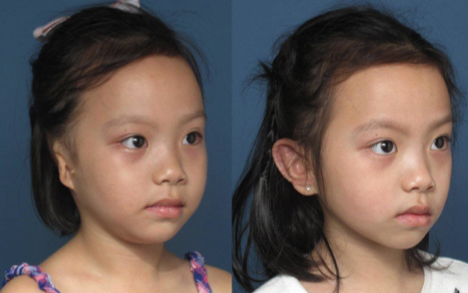
One Surgery: Medpor® Ear Reconstruction

One Surgery: Medpor® Ear Reconstruction
If your child does not qualify for either of these two methods, Dr. Reinisch can refer you to a specialist for a silicone prosthetic ear.
What to Expect after Microtia Treatment
The MEDPOR technique typically requires just one surgery. In some cases, however, your child may require a second procedure for cosmetic reasons. During this latter minor surgery, Dr. Reinisch will reshape the earlobe. Thanks to his skill, your child should experience minimal discomfort after MEDPOR surgery. In fact, most patients simply require Tylenol® or similar non-prescription medications. For three weeks, your child will need to wear a special cup to protect his or her new ear. You should expect the ear to be somewhat red and swollen. You will also see scars from the skin graft. Fortunately, redness should subside within two weeks and scars will begin to fade after that. In about six months, the new ear should be fully developed.
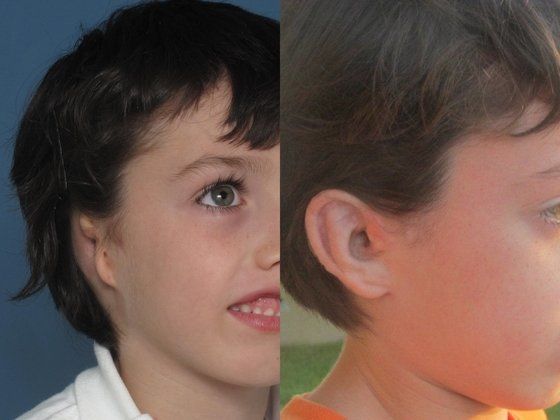
MEDPOR can dramatically improve the appearance of an ear affected by microtia.
MEDPOR ears function just like natural ears. After the initial healing period, your child should be able to engage in normal activities, including sports, just like his or her peers. Of course, it is always possible for an ear to become damaged. However, the risks are just as high for biological ears. The implant will not grow. Accordingly, your child’s ear will remain the same size for life. The earlobe will develop normally, corresponding to the lobe on the opposite ear.
The Cost of Microtia Treatment
Microtia treatment is typically covered by insurance. Our office staff is happy to work with your provider to help you obtain the maximum amount of coverage. At the same time, we are passionate about treating patients of all backgrounds, including those from other countries and those without insurance. To better meet your needs, we offer various forms of financing and monetary assistance. We accept CareCredit® and can help you apply for an appropriate plan. Dr. Reinisch also founded the Small Wonders Foundation. This non-profit organization is dedicated to helping the families of children with congenital defects. To serve our long-distance patients, we partner with the Ronald McDonald House, providing housing to family members as their children recover from surgery. We also have number of area host families. If you are concerned about the cost of treatment, please talk to our friendly staff who would be happy to answer your questions.
Video: Microtia Treatment Options
We Can Answer Your Questions
When your child has microtia, it is easy to be overwhelmed with the number of surgical options available. Dr. Reinisch educates parents regarding the different treatments, as well as the advantages and disadvantages of each. He wants you and your child to be comfortable with the treatment that you select and he will guide you as you make important decisions that will affect your little one’s future.
You may be unaware of the range of medical specialists involved with microtia treatment. You may also have concerns regarding how to talk to your child about the condition. Perhaps you are wondering why you should choose surgery for your child when he or she is perfectly happy with a small ear. Maybe it is confusing about why this congenital deformity was not picked up during a prenatal ultrasound. Dr. Reinisch and his team are always happy to answer your questions and address your concerns.
Can my child hear? Will this affect my child’s speech development?
Children with microtia and atresia affecting one ear will have problems locating the direction of sound and have trouble hearing a conversation in noisy environments, but the need for a hearing device is controversial. When your child begins school, you should make sure you child has preferential seating that will enable them to hear the teacher best. If your child has microtia with hearing loss on both sides, it is important to improve your child’s hearing with a bone-conducting hearing aid such as BAHA. It should be fitted before the age 6 months. The sounds that babies hear in the first year of life are very important for speech and language development.
Which specialists would I need to contact?
There are several specialists that may be involved in your child’s care. Centers that have a Craniofacial Team or Microtia Team are well-equipped to work together to best provide for your child. Children with microtia would benefit from having:
- Craniofacial Pediatric Plastic Surgeon — the craniofacial surgeon will have completed training in general surgery, plastic surgery, and a fellowship in craniofacial surgery at a children’s hospital.
- Otologist — a surgeon that specializes in ears. The otologist will determine if your child is a good candidate for canal surgery and perform the surgery in conjunction with your ear reconstruction surgery. Depending on which treatment you decide for your child, you may need the canal made before, after, or in some cases during the ear reconstruction.
- Audiologist — a hearing specialist that performs hearing tests and coordinates hearing aids and other devices.
- Geneticist — a physician that specializes in categorizing different syndromes and counseling families on the possibility of future generation having microtia.
- Pediatric Oral Surgeon/Orthodontist — a surgeon that provides information on jaw alignment which can sometimes be affected on children with other syndromes such as Hemifacial Microsomia
- Social Worker — a social worker supports and counsels the patient and family affected by microtia to help them cope with the condition. They can help prepare the child for surgery.
- Speech Therapist — a specialist in diagnosing and treating any disorders of speech which can occur as a result of craniofacial deformities.
At our hospital, we have a specific Microtia Team within our Craniofacial Group, so we can organize all your appointments in one afternoon.
How do I talk to my child about surgery?
We have found that surgery is much harder on parents than their children and most parents respond afterwards that it was much easier on their child than they thought it would be. At our hospital, we have Child Life Services that advise parents on preparing their children for surgery. They can be reached at 310-423-2380.
Why should I put my child through surgery when they are perfectly happy with a small ear? Am I doing the surgery for my child or for me?
Many parents continue to ask this same question even after they decide to have the surgery done. As a parent, you are your child’s greatest advocate. Families should decide which option is best for their child based on as much information as they can gather. Parents often find the best support from other parents who have already been through the process. There are several Yahoo support groups for microtia that you can join to assist you with your decision. Many parents create a blog of their child’s journey throughout the entire surgical process. Reading these blogs may be helpful in making your choice for your child.
Some suggestions from other parents
- Take time to work through all the emotions you are feeling. Please know that there are other parents who have felt the very same way you are feeling and that understand the emotions you are feeling.
- Talk about your feelings, fears, and concerns with your partner, a family member or close friend. It may help you feel better to talk about these things.
- Don’t blame yourself — there is nothing that you did or didn’t do that caused your child’s microtia. It is difficult to not focus on the things that are different about your child, but try to concentrate on everything that is wonderful about your beautiful new baby.
- Learn as much as you can about microtia. It is amazing how much you will learn in a small amount of time.
- Become an advocate for your child. This means, educate yourself about this condition and speak up for whatever you feel is in your child’s best interests.
Why wasn’t this picked up during my ultrasound?
There are several abnormalities that can be detected on an ultrasound, but ultrasound technicians usually focus on the
major organs. External ears are not routinely checked during an ultrasound and may be difficult to assess.

One Surgery: Medpor® Ear Reconstruction
Contact Reinisch Plastic Surgery
If your child is suffering from microtia, we are ready to provide the compassionate care that he or she deserves. Contact us online for more information or to book an appointment at our Beverly Hills office. You can also call us at (833) 896-3277.

